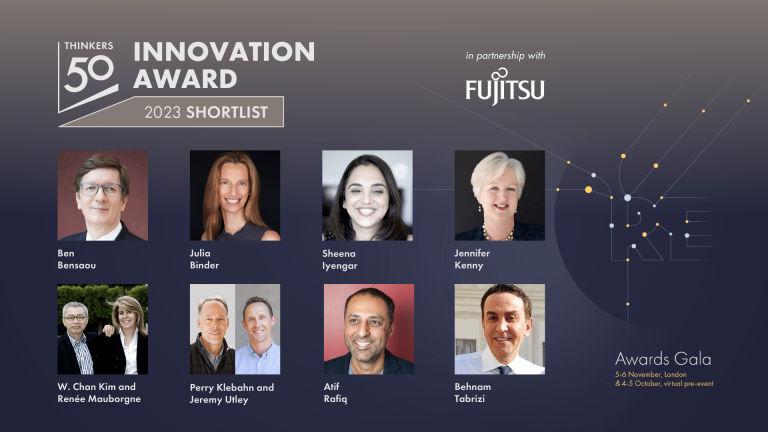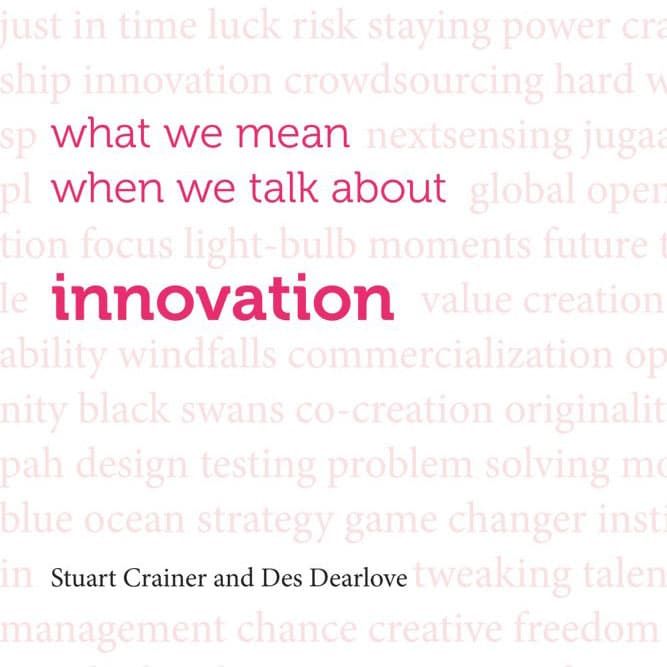

An entire vocabulary of platitudes and clichés has been built around the idea of innovation. When we spoke, Alf Rehn (shortlisted for the Thinkers50 Innovation award in 2015) quoted a quip from the CEO of a technology company he had recently met: “If we innovated even one percent of the times we use the word, we’d be the biggest company in the world…” This may sound depressingly familiar.
All the talk in the world doesn’t make a company innovative. Indeed, it may have quite the reverse effect. Alf Rehn suggests some antidotes to corporate blandness and the lack of meaning which creeps incessantly into any discussion of innovation.
“You can’t ban a word, but you can use it better,” says Rehn. “Blanket bans of words simply do not work, as they feel artificial and capricious. That said, leaders can set a good example by using certain words (I’m looking at you, ‘disruption’) in a more measured way, and by explaining their usage. In one company, we called it “the Why? principle”, where top management all committed to only using terms such as innovation if they could then explain why they’d done so: “This is an innovative project, and I will now explain why I say that…”
Rehn suggests that examples beat catchphrases: “Many CEOs make demands for innovation and disruption from their staff without clearly communicating what they have in mind. In one project I tasked a retail CEO to always use an example of the kind of innovation he was looking for when using the term, and taking notes of how this changed the shape of the discussion. He later reported that this had led to an overall greater engagement in the innovation discussion, as well as a marked increase in the number of innovation ideas submitted to him.”
A lot of this is concerned with creating a vibrant and practical debate around the idea of innovation. Rehn advocates that companies encourage innovation critique: “Incentivize people to speak up when they feel innovation talk lapses into empty phrases. Allow people to criticize what is presented as being an “innovation”, without fear of reprisals. Without criticism, a culture will start using the word in more and more vague ways, and it is this emptying of meaning that creates what I’ve called innovation fatigue.”
An interesting element of the communication challenge in the field of innovation is that in some ways innovation is a self-fulfilling prophecy – or can be. Those companies which market themselves as innovative are often perceived as such. Those which fail to do so languish in obscurity – even if they are actually highly innovative. This seems unimportant, but is crucial when it comes to recruiting the best and most innovative people.
Alessandro di Fiore of ECSI Consulting argues that developing innovation capabilities is no longer enough. For organizations, innovation marketing is the next frontier. “Appearances are important. Look at leadership. How a leader looks and behaves in front of followers is key to the successful practice of leadership. But, while we accept the importance of appearances in a range of business disciplines – marketing and communication for example – in some it is strangely under-valued,” says di Fiore.
ECSI’s research compared the Innovation Premium — the difference between the market cap and the NPV of cash flows – of a number of major corporations. The research discovered that the Innovation Premiums vary significantly among companies with the same financial fundamentals, even within the same industry. Looking at what differentiated these companies, ECSI found that where companies differ is primarily in their ability to explain to investors that they can sustain innovation. “In innovation, reputation is crucial, being seen to be innovative is a vital differentiator. Seeing is believing,” concludes di Fiore.
He cites Salesforce.com, the San Francisco-based CRM company, as an exemplar. Its Innovation Premium is 78 percent, almost double the industry average. This, the ECSI work suggests, is down to Salesforce.com’s ability to market the company’s innovativeness across different channels.
“The reality is that innovation is a battle which has to be fought on two fronts,” says Alessandro di Fiore. “First, companies have to develop their innovation capabilities. Building long-lasting capabilities throughout the organization lays the foundation for enduring innovation and growth. Today, most companies understand the importance of this first lever to sustain future performances. The real challenge here concerns execution.
“The second front is the world of appearances. Compared to developing innovation capabilities, innovation marketing is neglected. But, our research suggests that it is vital. Investors need to be informed and convinced of a company’s ability to continue to innovate far into the future. This means being able to build a thought leadership profile on innovation, be known and perceived as an innovative company at the leading edge in your industry.”
It is not enough to be innovative, you have to be seen to be.
Resources
www.alfrehn.com
www.ecsiconsulting.com
This was originally published in What we mean when we talk about innovation by Stuart Crainer and Des Dearlove (Infinite Ideas, 2016).

Thinkers50 Limited
The Studio
Highfield Lane
Wargrave RG10 8PZ
United Kingdom

Thinkers50 Limited
The Studio
Highfield Lane
Wargrave RG10 8PZ
United Kingdom

Thinkers50 Limited
The Studio
Highfield Lane
Wargrave RG10 8PZ
United Kingdom
| Cookie | Duration | Description |
|---|---|---|
| LANG | 9 hours | Linkedin set this cookie to set user's preferred language. |
| nsid | session | This cookie is set by the provider PayPal to enable the PayPal payment service in the website. |
| sp_landing | 1 day | The sp_landing is set by Spotify to implement audio content from Spotify on the website and also registers information on user interaction related to the audio content. |
| sp_t | 1 year | The sp_t cookie is set by Spotify to implement audio content from Spotify on the website and also registers information on user interaction related to the audio content. |
| tsrce | 3 days | PayPal sets this cookie to enable the PayPal payment service in the website. |
| x-pp-s | session | PayPal sets this cookie to process payments on the site. |
| __cf_bm | 30 minutes | This cookie, set by Cloudflare, is used to support Cloudflare Bot Management. |
| Cookie | Duration | Description |
|---|---|---|
| l7_az | 30 minutes | This cookie is necessary for the PayPal login-function on the website. |
| Cookie | Duration | Description |
|---|---|---|
| CONSENT | 2 years | YouTube sets this cookie via embedded youtube-videos and registers anonymous statistical data. |
| _ga | 2 years | The _ga cookie, installed by Google Analytics, calculates visitor, session and campaign data and also keeps track of site usage for the site's analytics report. The cookie stores information anonymously and assigns a randomly generated number to recognize unique visitors. |
| _gat_gtag_UA_10408481_1 | 1 minute | Set by Google to distinguish users. |
| _ga_ZP8HQ8RZXS | 2 years | This cookie is installed by Google Analytics. |
| _gid | 1 day | Installed by Google Analytics, _gid cookie stores information on how visitors use a website, while also creating an analytics report of the website's performance. Some of the data that are collected include the number of visitors, their source, and the pages they visit anonymously. |
| Cookie | Duration | Description |
|---|---|---|
| NID | 6 months | NID cookie, set by Google, is used for advertising purposes; to limit the number of times the user sees an ad, to mute unwanted ads, and to measure the effectiveness of ads. |
| test_cookie | 15 minutes | The test_cookie is set by doubleclick.net and is used to determine if the user's browser supports cookies. |
| VISITOR_INFO1_LIVE | 5 months 27 days | A cookie set by YouTube to measure bandwidth that determines whether the user gets the new or old player interface. |
| YSC | session | YSC cookie is set by Youtube and is used to track the views of embedded videos on Youtube pages. |
| yt-remote-connected-devices | never | YouTube sets this cookie to store the video preferences of the user using embedded YouTube video. |
| yt-remote-device-id | never | YouTube sets this cookie to store the video preferences of the user using embedded YouTube video. |
| yt.innertube::nextId | never | This cookie, set by YouTube, registers a unique ID to store data on what videos from YouTube the user has seen. |
| yt.innertube::requests | never | This cookie, set by YouTube, registers a unique ID to store data on what videos from YouTube the user has seen. |
| Cookie | Duration | Description |
|---|---|---|
| DEVICE_INFO | 5 months 27 days | No description |
| loglevel | never | No description available. |
| m | 2 years | No description available. |
Thinkers50 Limited has updated its Privacy Policy on 28 March 2024 with several amendments and additions to the previous version, to fully incorporate to the text information required by current applicable date protection regulation. Processing of the personal data of Thinkers50’s customers, potential customers and other stakeholders has not been changed essentially, but the texts have been clarified and amended to give more detailed information of the processing activities.